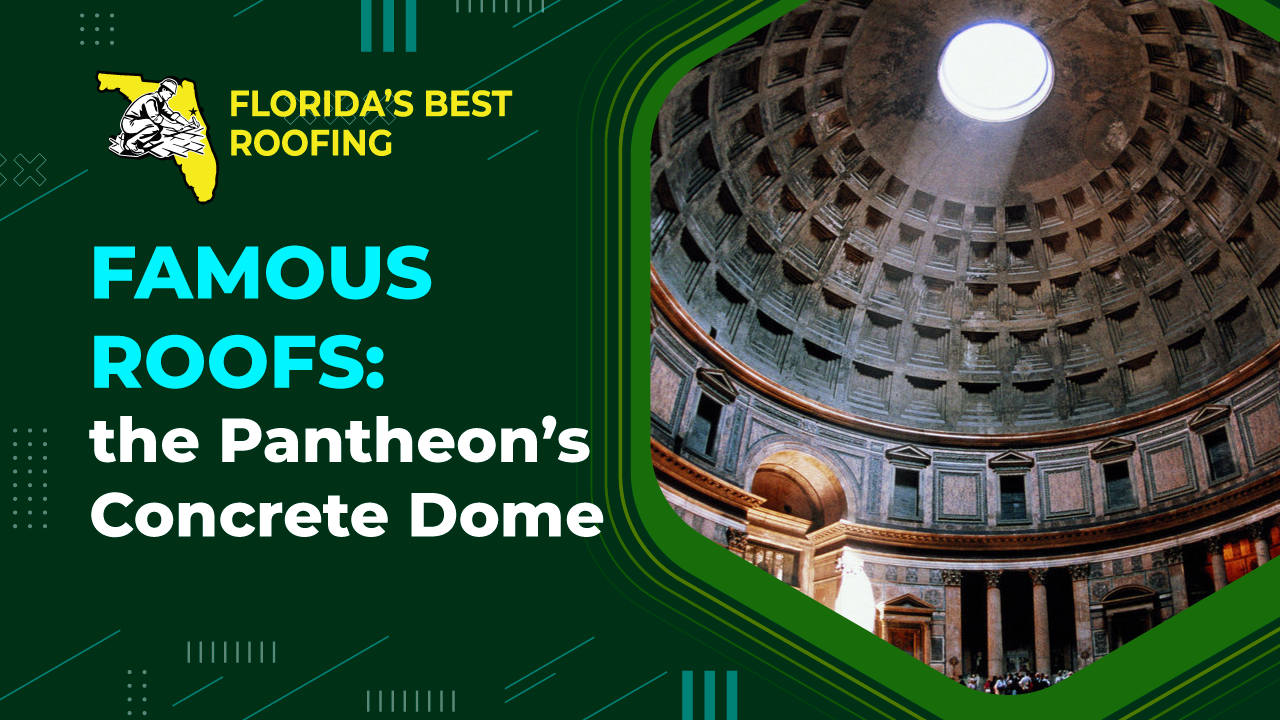Roofing may often seem like a jargon-filled, technical, and tedious subject which people only take an interest in when it comes time to repair or replace their own roof, but that’s not alway the case. As we have tried to show with previous posts, it can be a fascinating part of history, literature, and art. A roof is an integral part of the architecture of a building and at times advances in roofing have led to significant advances in the field of architecture and to the construction of some fascinating buildings which have stood for hundreds of years and still survive to this day! In the next few posts we will cover some of these buildings, their history, and most importantly, their roofs!
The first on our list is a building that is about two thousand years old and still standing in the city of Rome in Italy today. This building was originally called the Pantheon and is still known mostly by that name; however, some hundred years after it was built it was turned into a church and renamed The Church of Saint Mary and the Martyrs, so it still goes by that name too. The original building was built a couple of decades before the current era, making it about two thousand and fifty years old, but that structure burnt down about a century later and was rebuilt before burning down again and being rebuilt a second time in the early 100s. It was called by the ancient Romans the Pantheon, which would translate in English to “All the Gods,” referring to the polytheistic pantheon of many gods that the Romans worshiped. Although the building had something to do with Roman deities, it was not strictly a temple. Its function is not easily defined, but that is not the main topic of this post, and for the majority of its life the building has and continues to serve as a Catholic church.
For us what is most interesting about the building is its architecture, which was incredibly innovative for its time and inspired many future buildings, such as the US capitol building in Washington D.C. The building is round (that is, in the shape of a circle) and fronted by a rectangular portico which is held up by a series of decorated columns. The portico is topped by a triangular pediment, which is typical of ancient Roman temple construction, but the interesting part is that the round main part of the building has a rotunda–an unreinforced domed roof of Roman concrete–the only one of its kind.
The inspired engineering of the unreinforced dome, which distributes and lowers its weight, has enabled the structure to withstand the test of time, appropriation of portions of its construction materials for other purposes, and countless regime changes and conflicts that have shaken the city of Rome over the last two millennia. At the bottom the dome rests on a 21 foot thick drum wall interspaced with eight barrel vaults which bear the downward thrust of the dome. In this area the dome is as thick as the drum wall and made of concrete with travertine aggregate. Travertine is a type of limestone which is fairly dense and heavy. To lighten the weight of the load, the aggregate in the concrete used to create the roof was changed higher up. Above the travertine layer the thickness of the dome tapers down and the aggregate is made up of terracotta tile fragments. Finally, at the top the aggregate consists of tufa and pumice stone pieces. These stones are very porous and light, making them ideal for reducing the weight of the dome at the top. The thickness of the dome also tapers down to 3.9 feet at the very top.
Another element that strengthens the domed roof is that it does not meet up at an apex at the top. Instead, a portion of the roof is missing to form an oculus that is 28.4 feet in diameter. Although all these numbers seem fairly arbitrary, the measurements make much more sense in the ancient Roman measurement of a foot. In those terms, the rotunda has a diameter of 150 Roman feet and the oculus is 30 Roman feet in diameter. The oculus is left completely open to the elements, but since the interior flooring is made of various forms of sectioned marble to create a decorative pattern it stands up very well to the elements.
As an ancient marvel, the Pantheon is open daily to tourists outside of the times when Catholic mass is held in the church. Outside of the architecture, there are many other fascinating facts about the structure, such as its decorative program, its use to entomb significant figures in Italian history, and its continuous use throughout its history.
If you have any questions about roofs, we would be happy to help you out. Florida’s Best Roofing, Inc. is a fully licensed (CCC 1325974) and insured, local roofing contractor with decades of experience. If you are interested in roof replacement or repair and you are in the Palm Coast, Flagler, or Volusia area, please give us a call at 386-263-7906 for a free estimate!



